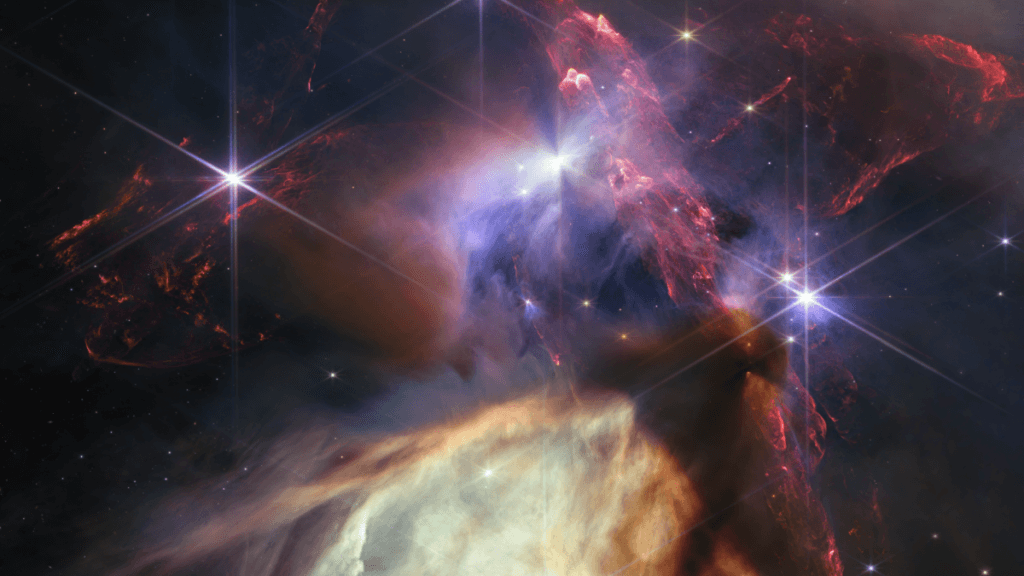To mark the one-year anniversary of James Webb Space Telescope observations on Wednesday (July 12), NASA has released a stunning image that shows star birth in a way that it has never been seen before.
The new James Webb Space Telescope (JWST) image features the closest star-forming region to Earth, the Rho Ophiuchi cloud complex. Though a small and relatively peaceful stellar nursery, the powerful telescope’s visualization represents a chaotic close-up of the region located 390 light-years from Earth.
“The JWST’s image of Rho Ophiuchi allows us to witness a very brief period in the stellar lifecycle with new clarity,” a JWST project scientist at the Space Telescope Science Institute in Baltimore, Maryland, Klaus Pontoppidan said in a statement. “Our own Sun experienced a phase like this long ago, and now we have the technology to see the beginning of another’s star’s story.”
In the image, it is possible to see jets bursting from some of the 50 or so young stars in the stellar nursery impacting surrounding interstellar gas and causing molecular hydrogen to glow red. These occur as the young stars are ripping free of their natal cocoons comprised of what remains of the gas and dust that formed them. This makes the bright jets almost equivalent to a newborn baby stretching its arms for the very first time.
Related: JWST time travels billions of years in amazing 3D visualization (video)
The makings of a protoplanetary disk of gas and dust from which planets will eventually form can also be seen in the form of shadows around some of the young blue stars. The darkest areas in the JWST image are regions in which protostars are still being born in the Rho Ophiuchi.
Though most of the stars in the region are of sizes similar to or smaller than the sun, one much more massive star than ours lurks in the lower half of the image. This massive blue star, S1, has cleared out a cave of dust in the glowing yellow material that surrounds it.
The image that shows stellar birth in whole new light demonstrates that as incredible as the first year of the JWST has been, the start of the second year of science from the telescope suggests we haven’t seen anything yet.
“In just one year, the James Webb Space Telescope has transformed humanity’s view of the cosmos, peering into dust clouds and seeing the light from faraway corners of the universe for the very first time,” NASA Administrator Bill Nelson said in a statement. “Every new image is a new discovery, empowering scientists around the globe to ask and answer questions they once could never dream of.”
Read more: See amazing images from James Webb Space Telescope’s 1st year gazing deep into the cosmos (photos)
A year of James Webb Space Telescope space science
The first image from the JWST was released on July 11, 2022, when U.S. President Joe Biden revealed a deep field picture of thousands of galaxies in the galactic cluster SMACS 0723, during a public event at the White House in Washington.
The following day, in a live broadcast from NASA’s Goddard Space Flight Center in Greenbelt, Maryland, a further three images were released to the public. These included a stunning image of the orange-hued gaseous hills of the NGC 3324 star region in the Carina Nebula, the striking visualization of the five galaxies of Stephan’s Quintet, and a picture of the Southern Ring Nebula, a halo of gas surrounding a star located 2,500 light-years away.
Also contained within this first data set released on July 12, 2022, were the JWST’s observations of the atmospheric composition of the hot gas giant exoplanet WASP-96 b.
Not only did the images and data impress the public, but even astronomers and scientists who had helped develop the JWST were taken aback by the telescope’s precision and power, getting a taste of the kind of contribution it would make to astronomy.
Related: James Webb Space Telescope images: 12 astonishing views of our universe (gallery)
The first year of operation of the JWST has not disappointed on this front. The telescope is designed to view the universe in infrared, and this makes it particularly adept at observing early galaxies.
This is because the light that left these galaxies billions of years ago has lost energy as it travels billions of light-years to reach energy, and this results in light having its wavelength shifted toward the red end of the electromagnetic spectrum.
The process called “redshift” sees visible light shifted down to infrared light, and the longer this light has traveled from the most distant and, thus, earliest galaxies, the more extreme this redshift has been.
The infrared view of the JWST has allowed the $10 billion space telescope to visualize the most distant and, thus earliest galaxies ever seen by humanity.
The four earliest galaxies, designated JADES-GS-z10–0, JADES-GS-z11–0, JADES-GS-z12–0, and JADES-GS-z13–0 (JADES stands for JWST Advanced Deep Extragalactic Survey), are seen by the JWST as they were when the 13.8 billion-year-old universe was just 300 to 500 million years old.
What has perhaps been even more surprising in the first 12 months of science delivered by the JWST is how useful this powerful instrument designed to see deeper into the universe and thus further back in time than any telescope before it has been when imaging objects within our cosmic backyard.
In the solar system, the JWST has been able to deliver stunning views of the gas giant Jupiter, the ice giant Uranus, and, most recently, the ringed planet Saturn.
“With a year of science under our belts, we know exactly how powerful this telescope is and have delivered a year of spectacular data and discoveries,” JWST Senior Project Scientist Jane Rigby said. “We’ve selected an ambitious set of observations for year two — that builds on everything we’ve learned so far. The JWST’s science mission is just getting started — there’s so much more to come.”

